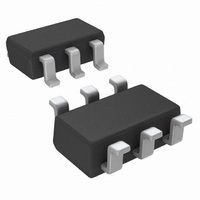ADC121S101CIMF/NOPB National Semiconductor, ADC121S101CIMF/NOPB Datasheet - Page 12

ADC121S101CIMF/NOPB
Manufacturer Part Number
ADC121S101CIMF/NOPB
Description
IC ADC 12BIT 1MSPS SOT23-6
Manufacturer
National Semiconductor
Series
PowerWise®r
Datasheet
1.ADC121S101CIMFNOPB.pdf
(18 pages)
Specifications of ADC121S101CIMF/NOPB
Number Of Bits
12
Sampling Rate (per Second)
1M
Data Interface
DSP, MICROWIRE™, QSPI™, Serial, SPI™
Number Of Converters
1
Power Dissipation (max)
10mW
Voltage Supply Source
Single Supply
Operating Temperature
-40°C ~ 125°C
Mounting Type
Surface Mount
Package / Case
SOT-23-6
Number Of Elements
1
Resolution
12Bit
Architecture
SAR
Sample Rate
1MSPS
Input Polarity
Unipolar
Input Type
Voltage
Rated Input Volt
5.25V
Differential Input
No
Power Supply Requirement
Single
Single Supply Voltage (typ)
3.3/5V
Single Supply Voltage (min)
2.7V
Single Supply Voltage (max)
5.25V
Dual Supply Voltage (typ)
Not RequiredV
Dual Supply Voltage (min)
Not RequiredV
Dual Supply Voltage (max)
Not RequiredV
Differential Linearity Error
±1LSB
Integral Nonlinearity Error
-1.1LSB/1LSB
Operating Temp Range
-40C to 125C
Operating Temperature Classification
Automotive
Mounting
Surface Mount
Pin Count
6
Package Type
SOT-23
Input Signal Type
Single-Ended
For Use With
ADC121S101EVAL - BOARD EVALUATION FOR ADC121S101
Lead Free Status / RoHS Status
Lead free / RoHS Compliant
Other names
ADC121S101CIMF
ADC121S101CIMFTR
ADC121S101CIMFTR
Available stocks
Company
Part Number
Manufacturer
Quantity
Price
Company:
Part Number:
ADC121S101CIMF/NOPB
Manufacturer:
TI
Quantity:
3 000
www.national.com
Applications Information
1.0 ADC121S101 OPERATION
The ADC121S101 is a successive-approximation analog-to-
digital converter designed around a charge-redistribution dig-
ital-to-analog converter core. Simplified schematics of the
ADC121S101 in both track and hold modes are shown in
Figure 3
in track mode: switch SW1 connects the sampling capacitor
to the input, and SW2 balances the comparator inputs. The
device is in this state until CS is brought low, at which point
the device moves to hold mode.
2.0 USING THE ADC121S101
The serial interface timing diagram for the ADC is shown in
Figure
ADC and frames the serial data transfers. SCLK (serial clock)
controls both the conversion process and the timing of serial
data. SDATA is the serial data out pin, where a conversion
result is found as a serial data stream.
Basic operation of the ADC begins with CS going low, which
initiates a conversion process and data transfer. Subsequent
rising and falling edges of SCLK will be labelled with reference
to the falling edge of CS; for example, "the third falling edge
of SCLK" shall refer to the third falling edge of SCLK after
CS goes low.
At the fall of CS, the SDATA pin comes out of TRI-STATE,
and the converter moves from track mode to hold mode. The
input signal is sampled and held for conversion on the falling
edge of CS. The converter moves from hold mode to track
mode on the 13th rising edge of SCLK (see
this point that the interval for the t
the worst case, 350ns must pass between the 13th rising
2. CS is chip select, which initiates conversions on the
and
Figure
4, respectively. In
ACQ
specification begins. In
Figure
FIGURE 3. ADC121S101 in Track Mode
FIGURE 4. ADC121S101 in Hold Mode
Figure
3, the device is
2). It is at
12
Figure 4
nects the sampling capacitor to ground, maintaining the sam-
pled voltage, and switch SW2 unbalances the comparator.
The control logic then instructs the charge-redistribution DAC
to add or subtract fixed amounts of charge from the sampling
capacitor until the comparator is balanced. When the com-
parator is balanced, the digital word supplied to the DAC is
the digital representation of the analog input voltage. The de-
vice moves from hold mode to track mode on the 13th rising
edge of SCLK.
edge and the next falling edge of SCLK. The SDATA pin will
be placed back into TRI-STATE after the 16th falling edge of
SCLK, or at the rising edge of CS, whichever occurs first. After
a conversion is completed, the quiet time t
isfied before bringing CS low again to begin another conver-
sion.
Sixteen SCLK cycles are required to read a complete sample
from the ADC. The sample bits (including leading zeroes) are
clocked out on falling edges of SCLK, and are intended to be
clocked in by a receiver on subsequent falling edges of SCLK.
The ADC will produce three leading zero bits on SDATA, fol-
lowed by twelve data bits, most significant first.
If CS goes low before the rising edge of SCLK, an additional
(fourth) zero bit may be captured by the next falling edge of
SCLK.
2.1 Determining Throughput
Throughput depends on the frequency of SCLK and how
much time is allowed to elapse between the end of one con-
version and the start of another. At the maximum specified
shows the device in hold mode: switch SW1 con-
20145009
20145010
QUIET
must be sat-









